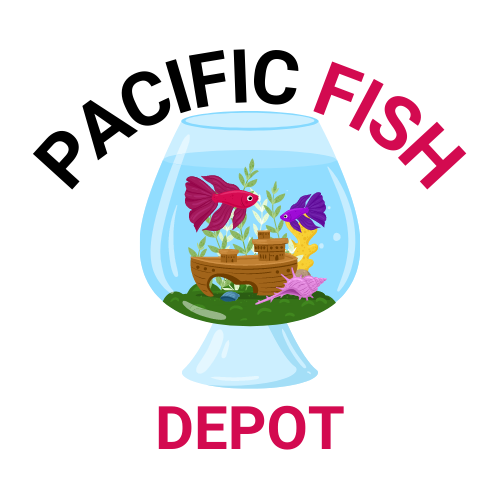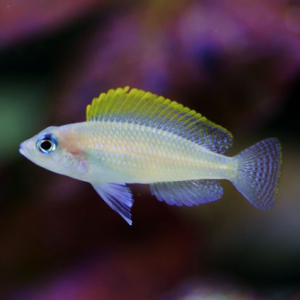No products in the cart.
Lemon Cichlid
$25.00
Lemon Cichlids are cave spawners and will readily breed in a well-maintained tank. Pairs form and choose a crevice or cave in which the female will lay eggs. The male guards the entrance, and the female tends to the eggs and fry. The fry hatch within a few days and begin free-swimming shortly after.
Where to Buy Lemon Cichlid
The Lemon Cichlid, scientifically known as Neolamprologus leleupi, is a brilliantly colored freshwater fish native to Lake Tanganyika in East Africa. Its radiant yellow to golden-orange body and curious, engaging personality make it a favorite among aquarists seeking both beauty and behavioral interest in their tanks. With its slender body and neon glow, the Lemon Cichlid brings a lively contrast to rocky aquascapes and biotope setups.
You can now purchase healthy, tank-raised Lemon Cichlids from Pacific Fish Depot, where quality and expert handling are always guaranteed.
Appearance and Behavior
One of the most visually striking Tanganyikan cichlids, the Lemon Cichlid’s coloration ranges from lemon-yellow to deep orange, depending on lighting, water conditions, and genetic lineage. Both males and females are equally colorful, though males tend to grow slightly larger, reaching up to 4 inches in length.
This species is known for its inquisitive nature. Often seen darting in and out of rockwork, they form territories in crevices or caves and become quite interactive with their environment. They are relatively peaceful when housed correctly but can be territorial, especially during breeding.
Tank Setup and Requirements
The Lemon Cichlid thrives in aquariums that mimic the rocky terrain of Lake Tanganyika. An ideal tank includes vertical rock formations, caves, and hiding spaces. These fish need clean, hard, alkaline water to maintain their vibrant coloration and good health.
Recommended tank parameters:
Tank size: 30 gallons for a single pair; larger for multiple fish
Temperature: 76–80°F (24–27°C)
pH: 8.0–9.0
Water hardness: 10–20 dGH
Décor: Caves, slate rock structures, minimal plants
Substrate: Fine sand or aragonite
Water quality is essential. Regular water changes and biological filtration will support their well-being. These fish can be kept solo, in pairs, or in carefully managed communities.
Diet and Feeding
In the wild, Lemon Cichlids are opportunistic carnivores. They consume insect larvae, small crustaceans, and plankton. In home aquariums, they adapt well to a varied carnivorous diet.
Ideal foods include:
High-quality cichlid pellets
Frozen mysis shrimp
Brine shrimp (live or frozen)
Bloodworms (occasionally)
Crushed krill
Avoid excessive flake food and ensure that protein makes up the bulk of their diet. Feed once or twice daily in small, manageable portions.
Compatible Tank Mates
Though moderately territorial, Lemon Cichlids are not overly aggressive. They can coexist with other Tanganyikan cichlids or peaceful bottom dwellers if tank size and structure support separate territories.
Compatible tank mates:
Julidochromis species
Shell dwellers (Multis, Brevis)
Cyprichromis (mid-water swimmers)
Synodontis catfish
Small plecos (in cooler water)
Avoid housing them with aggressive Mbuna or larger Central American cichlids. Stick with similarly tempered fish that won’t compete for the same rock zones.
Breeding Information
Lemon Cichlids are cave spawners and will readily breed in a well-maintained tank. Pairs form and choose a crevice or cave in which the female will lay eggs. The male guards the entrance, and the female tends to the eggs and fry. The fry hatch within a few days and begin free-swimming shortly after.
With multiple hiding spots and careful tank planning, even novice aquarists can experience the reward of breeding this species.
For scientific insights and wild behavior, check out Seriously Fish’s species profile, a trusted resource for aquarists.
Frequently Asked Questions
1. Are Lemon Cichlids aggressive?
They are semi-territorial but not overly aggressive. With enough space and caves, they coexist peacefully with suitable species.
2. How can I tell male from female?
Males are typically slightly larger and have more pointed fins. Females may be rounder, especially when carrying eggs.
3. What’s the best tank setup for them?
A rocky tank with vertical stonework and multiple caves, along with hard, alkaline water, mimics their natural environment.
4. Can they live in community tanks?
Yes, if their tank mates are peaceful and not overly dominant. Proper structure and space are crucial.
5. Will they breed easily in captivity?
Yes. Given good water conditions and cave-like structures, pairs form naturally and breed without intervention.
Be the first to review “Lemon Cichlid” Cancel reply
Related products
Sale!












Reviews
There are no reviews yet.